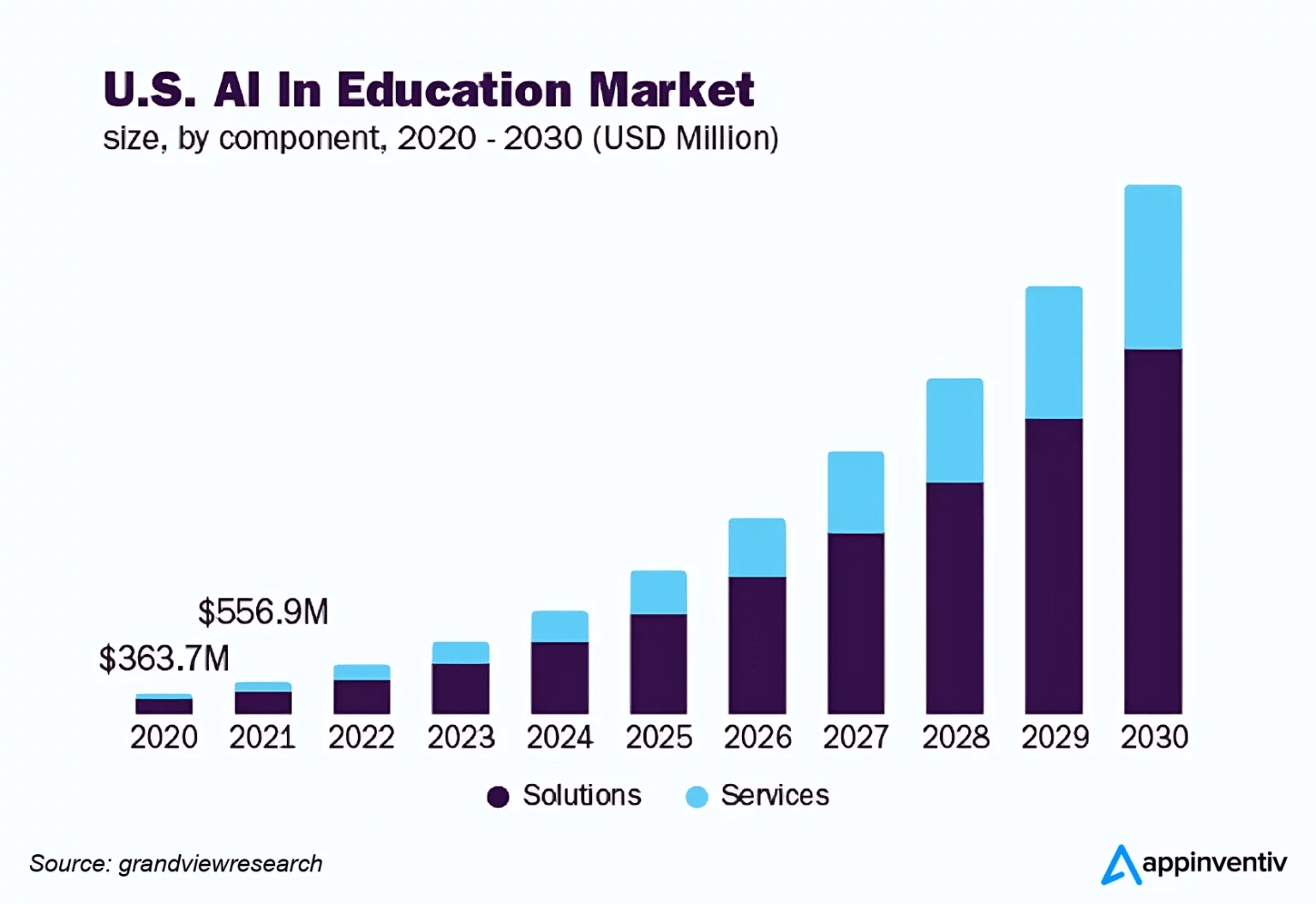Education is becoming more personalized by using technology that can adapt and learn. Learning can be designed to each student’s pace and style. For example, AI can help create lessons that adjust based on whether a student finds the material easy or hard. This helps keep all students engaged, whether they learn quickly or need more time.The importance of use of AI in education is becoming clearer as it reaches more places worldwide. Studies have shown that when schools use AI, students often perform better.
This is vital as education systems worldwide strive to prepare students for a rapidly changing job market. By integrating AI, schools are improving education outcomes and helping students become adept at using technology, which is essential in many modern careers. This change is key to ensuring education systems keep up with global trends and needs.
Current State of AI in Education

Source: https://appinventiv.com/blog/artificial-intelligence-in-education/
The use of AI in education is expanding rapidly, transitioning the way educational content is delivered and personalized. The web app development company integrate AI technologies into classrooms globally, offering tailored learning experiences that adapt to the needs of individual students.
Current AI Technologies in Education

Source: https://www.leewayhertz.com/ai-use-cases-in-education/
● Personalized Learning Systems
These tools use AI to adjust the difficulty of tasks based on the student’s performance, ensuring that each student is challenged just enough to stay engaged without feeling overwhelmed.
●Automated Grading
Students using AI is used to grade assignments and exams, providing immediate feedback to students and saving teachers valuable time.
● Intelligent Tutoring Systems
These systems provide one-on-one tutoring sessions that can help explain complex subjects in easier ways for each student to understand.
●Adoption Rates and Geographic Spread
In North America, AI adoption in schools has been particularly strong, with over 60% of districts implementing some form of AI by 2023.
Europe and Asia are closely following, with numerous educational institutions adopting AI tools for language processing, problem-solving, and administrative tasks.
Examples of Successful AI Integration
● Georgia State University
Here, an AI-powered advising system helps track student progress and flags potential issues before they become significant problems, reducing dropout rates.
● Primary Schools in Singapore
AI is utilized to teach mathematics and science, providing interactive and adaptive learning platforms that adjust to the ability level of each student.
Core Technologies and Their Applications

Source: https://www.holoniq.com/notes/2019-artificial-intelligence-global-education-report
AI is making a big difference in how we teach and learn in schools today. Here’s how different AI technologies are being used
Machine Learning
This technology allows systems to learn from data and improve over time. In schools, machine learning is used to create personalized learning paths for students. This means lessons can change based on what a student knows and how they learn best. For example, a study showed that students using AI as adaptive learning software, which adjusts content based on student responses, improved their math scores significantly compared to those who didn’t use the software.
Natural Language Processing (NLP)
NLP helps computers understand and respond to human language. In education, this technology is used for automated grading of written assignments and providing feedback, which helps students improve their writing more quickly. It’s also used in language learning apps to help students practice new languages by conversing with AI tutors.
Computer Vision
This technology enables computers to understand and interpret visual information. In classrooms, computer vision is used to track how engaged students are during lessons, which helps teachers adjust their teaching methods in real time. Additionally, it’s enhancing virtual reality (VR) environments, making them more interactive and immersive for subjects like history and science.
Robotics
Robots are being used in education, particularly in coding and STEM (Science, Technology, Engineering, and Mathematics) subjects. They provide a hands-on way for students to learn programming and problem-solving skills. For instance, robots are used in robotics classes where students learn to build and program their own robots, which has been shown to improve problem-solving skills.
Speech Recognition
Using AI in the classroom converts spoken words into text. It’s very helpful in language learning, where students can practice speaking and the system gives them immediate feedback. Speech recognition is also crucial in making learning more accessible for students with disabilities. For example, voice-activated tools help students who have difficulty using traditional computer interfaces due to physical limitations.
Each of these technologies shows how AI is transforming education, making it more personalized, engaging, and accessible for all students. As these technologies continue to develop, their impact is likely to grow, offering even more innovative ways to enhance learning experiences in schools around the world.
Case Study: How Brainly Used AI to Simplify Homework Help

Source: https://www.softwareadvice.com/product/500844-Brainly/
Challenge
Brainly, a global online learning platform, recognized that many students struggled to find the help they needed for homework, especially on mobile devices. This challenge became even more pressing during the shift to remote learning. Students needed a simple, fast, and effective way to get answers to their questions, but traditional methods were either too slow or lacked accessibility. Brainly wanted to create a solution that would make learning easier and more equitable for students worldwide.
Solution
To address this challenge, Brainly partnered with Google Cloud and leveraged its Vision AI technology. This collaboration allowed Brainly to introduce a game-changing feature students could simply take a photo of their homework question, and the platform would instantly provide relevant answers.
Google Cloud’s Vision AI recognized text in multiple languages, enabling Brainly to cater to its diverse, global audience. The system worked seamlessly across languages, ensuring students from different regions could use the feature without barriers. Additionally, Google Cloud’s scalability allowed Brainly to handle increased demand, especially as more students turned to online learning.
How AI Helped: The use of AI transformed Brainly’s platform in three key ways
- Instant Answers:Vision AI made it possible for students to snap a photo of a question and receive answers almost immediately.
- Global Reach: Multilingual capabilities allowed Brainly to serve students from all over the world, making learning more inclusive.
- Effortless Scalability: Google Cloud ensured that the platform could support the growing number of users, even during peak times.
Results The results of this AI-driven solution were impressive
- 70% Student Satisfaction Rate: Students appreciated the instant and accurate answers by using AI in education.
- 6x engagement boost: The photo query feature significantly increased student interaction on the platform.
- Increased Revenue From Subscriptions:
The improved experience encouraged more users to subscribe, boosting Brainly’s revenue.
Benefits of AI use in Education

Source: https://www.leewayhertz.com/ai-use-cases-in-education/
Personalization of Learning Experiences
AI helps tailor learning to each student’s needs. Every student learns differently, and AI-powered tools adapt to their pace and style. For example, platforms like Duolingo adjust lessons based on how quickly students grasp concepts, providing more practice for areas they struggle with. This personalized approach improves understanding and keeps students motivated. According to a study, personalized learning can increase student performance by up to 30-50%.
Scalability of Educational Resources
AI makes it possible to scale high-quality education to millions of students. Digital tools, like AI tutors, provide learning support anytime, anywhere. For instance, platforms like Khan Academy use AI to guide students through subjects like math, offering support similar to a one-on-one tutor. This scalability bridges the gap for students in areas where quality teaching is limited.
Increased Accessibility for Students with Disabilities
AI makes education more inclusive by addressing the needs of students with disabilities. Tools like speech-to-text software help students with hearing impairments, while text-to-speech programs assist those with visual impairments. One of the prime examples of artificial intelligence in education is Microsoft’s Immersive Reader, which supports dyslexic students by customizing text for better readability, making learning easier.
Data-Driven Insights for Educators and Policymakers
AI analyzes student performance data to help educators identify gaps and strengths. For instance, systems like Coursera provide detailed reports on how learners interact with courses. Policymakers can use these insights to improve education systems, ensuring resources are allocated where needed most.
Challenges and Ethical Considerations

Source: https://redresscompliance.com/ethical-issues-ai-education/
1. Data Privacy and Security
The use of AI in education often requires collecting and analyzing large amounts of student data, including performance, behavior, and personal information. This raises serious concerns about data privacy and security. If sensitive data falls into the wrong hands, it can lead to identity theft or misuse. For example, in 2022, some education platforms faced data breaches that compromised millions of student records. Schools and developers must prioritize strong encryption and clear policies to protect student privacy.
2. Bias in AI Algorithms
AI systems are only as unbiased as the data they’re trained on. If the data contains biases, the AI can reinforce inequalities. For instance, if an AI grading system is trained on biased data, it might unfairly assess students from underrepresented groups. Ensuring that training data is diverse and inclusive is critical to avoid perpetuating existing educational inequalities.
3. Digital Divide
AI-based tools often rely on technology like smartphones or internet access. However, not all students have access to these resources, creating a gap between those who can benefit from AI and those who cannot. According to UNESCO, around 2.7 billion people globally still lack internet access, making ensuring equal opportunities in AI-driven education harder.
4. Lack of Human Interaction
While AI can provide excellent support, it cannot replace the emotional connection and understanding that human teachers offer. Over-reliance on AI may reduce face-to-face interactions, which are essential for social and emotional learning. Students might feel isolated if AI becomes the primary mode of instruction.
5.Accountability and Transparency
AI decisions, like grades or learning recommendations, can sometimes be difficult to explain. If a student or parent questions why a certain decision was made, the “black box” nature of AI can make it hard to provide a clear answer. Transparent algorithms and clear communication are essential to build trust and accountability in AI-based educational systems.
Top Companies Using AI in Education Duolingo

Source: https://scalac.io/blog/duolingo-why-they-chose-scala/
Duolingo is one of the most popular language-learning platforms, using AI to personalize lessons for each user. Its AI system adapts to how well a learner performs, offering more practice in areas where they struggle and progressing faster in areas they excel. For instance, if a user finds verb conjugations challenging, the app focuses more on that. With over 500 million users worldwide, Duolingo’s AI-driven approach has made language learning accessible and effective for millions.
Coursera

Source: https://www.onethreadapp.com/blog/what-is-coursera/
Coursera uses AI to provide a personalized learning experience for its users. The platform analyzes how students engage with courses and offers recommendations based on their progress and interests. For example, if a user struggles with a specific topic, Coursera suggests additional resources or practice material. AI also helps Coursera recommend courses that align with learners’ career goals, making education more tailored and career-oriented.
Khan Academy

Source: https://www.productmonk.io/p/khan-academy-success-strategy
Khan Academy integrates AI into its learning platform to offer personalized math tutoring. With tools like Khanmigo, an AI-powered assistant, students get real-time guidance as they solve problems. Teachers also benefit from AI insights, which highlight areas where students need extra support. This AI-driven approach has significantly improved student outcomes globally.
Quizlet

Source: https://dlsdc.com/blog/quizlet/
Quizlet uses AI to create personalized study plans for students. Its “Learn Mode” adapts to a user’s progress, focusing on the terms and concepts they find most challenging. Quizlet’s AI also predicts which questions students are likely to struggle with, making studying more efficient. With over 60 million active users, Quizlet has transformed how students prepare for exams.
Pearson

Pearson, a leading education company, uses AI to improve both teaching and learning. Their AI-powered tools, like Pearson MyLab, provide personalized assignments and immediate feedback to students. The platform’s AI also helps educators track student performance and make data-driven decisions. Pearson’s AI solutions are used by millions of students and educators worldwide, bridging gaps in traditional learning.
Future Trends and Predictions for AI in Education

Source: https://www.quantzig.com/ai/ai-in-education-trends-shaping-the-future-of-learning/
Innovations on the Horizon What’s Next for AI in Education?
The future of AI in education looks exciting, with advancements like AI-powered virtual tutors, adaptive learning platforms, and immersive experiences using augmented reality (AR). Virtual tutors could become more sophisticated, acting as personal mentors for students, available 24/7 to help with their studies. Squirrel AI is one of the examples of AI in the classroom that is already developing AI tutors that mimic human interactions. Another trend is the rise of immersive learning, where AI combines with AR or virtual reality (VR) to create engaging simulations. Imagine the use of AI in schools where in history lessons students can “visit” ancient civilizations or science classes where they can explore space—all from their classrooms or homes.
Predictions for 2030 and Beyond
By 2030, AI could make education fully personalized. Each student may have a unique learning path based on their strengths, weaknesses, and interests. AI systems could predict career paths for students by analyzing their skills and preferences early on. Automation may also handle administrative tasks like grading, freeing up teachers to focus on fostering creativity and critical thinking. A UNESCO report predicts that AI could bridge the educational gap for millions of children in underserved areas, making quality education universally accessible.
Potential Shifts in Global Education Policies Due to AI
AI’s growing role in education could drive significant changes in global policies. Governments may focus on integrating AI tools into public education systems to reduce disparities. For instance, policies might mandate AI-driven platforms for personalized learning in schools or training programs for teachers to use AI effectively. Another shift could be the standardization of ethical AI use in education to protect student data and ensure fairness. Policymakers might also explore AI’s role in lifelong learning, helping adults reskill in a rapidly changing job market. Countries like Singapore are already investing in AI-based education systems, setting a precedent for others to follow.
Conclusion
As AI continues to redefine education, the possibilities are endless. Experts believe that by 2025, education will no longer be a one-size-fits-all approach. Instead, AI will enable personalized learning experiences that adapt to every student’s unique pace, strengths, and challenges. This level of customization could transition how students using AI engage with learning, making it more meaningful and effective. According to a World Economic Forum report, over 70% of educators believe that AI will play a critical role in fostering skills like creativity, problem-solving, and collaboration—areas that traditional education often overlooks. But what’s most exciting is how AI could make learning universally accessible, breaking down barriers of geography, language, and disability.
However, as we embrace this new frontier, we must also address the human side of this transformation. Experts warn that over-reliance on AI could shift how we perceive learning and interaction. While technology can provide answers, it’s the emotional and social aspects of education—like mentorship, teamwork, and empathy—that truly shape minds. One can hire frontend developers as AI takes over repetitive tasks, educators may have more time to nurture these human qualities. The real question is: will AI push us to rethink what it means to learn and grow academically and as humans? Only time will tell, and the future of education may hold surprises we’re only beginning to imagine.
SHARE THIS POST












